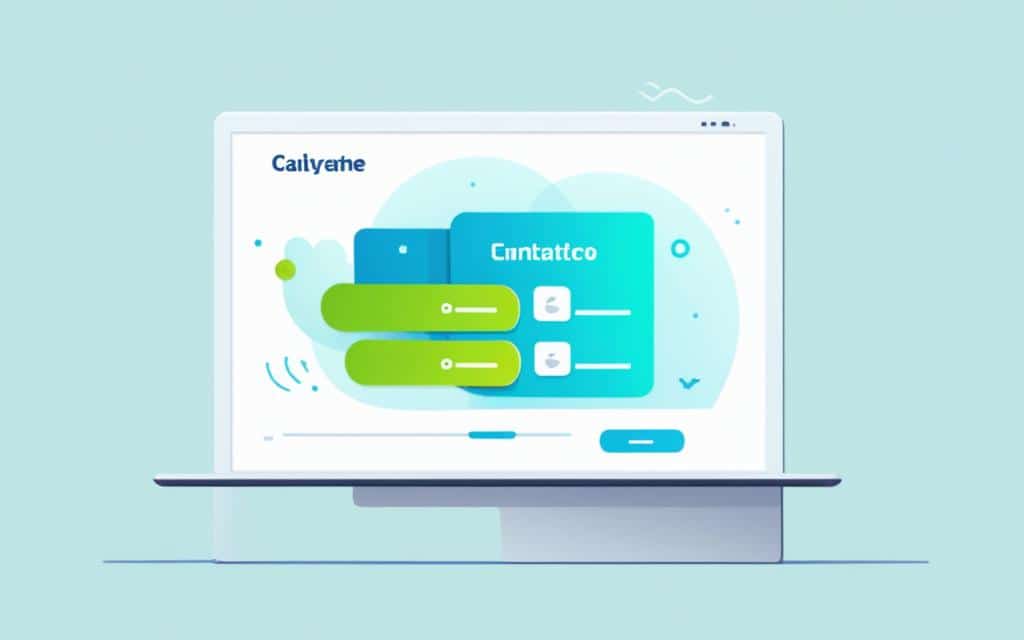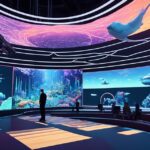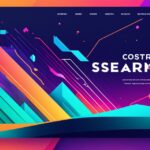Table of Contents
In today’s digital landscape, websites have evolved from being solely visually appealing to being powerful marketing tools with distinct functions and goals. Modern websites play a crucial role in achieving business objectives by optimizing user experience, generating leads, increasing brand awareness, and driving revenue growth. This article will explore the multifaceted nature of modern websites, going beyond aesthetics to uncover their true potential.
One aspect that contributes to the functionality and effectiveness of modern websites is web animation. Web animation refers to the use of motion and animated elements on a website to enhance the user experience and improve usability. It goes beyond simply adding visual appeal, but serves a purpose in guiding users, providing feedback, and creating engaging interactions.
Functional web animation can be strategically implemented to captivate the attention of visitors, communicate information effectively, and guide users through the website’s content. By incorporating subtle animations, such as hover effects or scrolling animations, websites can create a more dynamic and interactive experience.
Moreover, web animations can be used to convey complex information or processes in a visually engaging and easy-to-understand manner. This is particularly useful for presenting data, demonstrating product features, or illustrating step-by-step instructions. By breaking down complex concepts into digestible animations, websites can enhance user comprehension and facilitate decision-making.
In addition to enhancing user experience, web animation can also contribute to the overall aesthetics of a website. When used appropriately, animations can elevate the visual appeal and create a cohesive and memorable brand presence.
In conclusion, web animation goes beyond aesthetics and serves a functional purpose in enhancing the user experience, improving usability, and conveying information effectively. By leveraging the power of functional web animation, modern websites can truly unlock their potential and achieve their desired objectives. Stay tuned as we delve deeper into the various facets of modern website functionality in this article.
User Experience: Designing Websites for Optimal Usability
A positive user experience is vital for the success of any website. It goes beyond merely creating a visually appealing design. Websites should be designed with the target audience in mind, ensuring that users can navigate through the site effortlessly, find the information they need quickly, and have a seamless and enjoyable experience overall.
To achieve optimal usability, websites should employ user-centric design principles. This involves conducting thorough user research to understand the needs, preferences, and behaviors of the target audience. By gaining insights into their expectations and pain points, designers can tailor the website to meet and exceed user expectations.
One of the key factors in ensuring a positive user experience is providing seamless navigation. Users should be able to intuitively find their way around the website and locate the desired information or products without any confusion or frustration.
Effective navigation can be achieved through intuitive menu structures, clear labels, and consistent placement of navigation elements. By following established web design conventions, such as placing the main navigation at the top of the page, designers can make it easier for users to navigate and explore the website.
Optimizing Website Content
A well-designed website not only presents information in a visually appealing manner but also optimizes the content for readability. This includes using clear and concise language, breaking up long paragraphs into smaller sections, and using headings and subheadings to organize the content.
When optimizing website content, designers should also consider the use of relevant keywords. This improves search engine visibility, making it easier for users to find the website through organic search results. However, it is important to strike a balance between incorporating keywords and maintaining a natural flow of content, ensuring that the text remains engaging and informative.
The Role of User Experience in Conversions
Prioritizing user experience not only creates a positive impression but also increases the likelihood of conversions. When users have a seamless and enjoyable experience on a website, they are more likely to trust the brand and make a purchase, sign up for a newsletter, or perform any desired action.
In fact, research has shown that websites with a focus on user experience tend to have higher conversion rates. By understanding the needs and motivations of the target audience and designing the website accordingly, businesses can create a user-friendly environment that encourages users to take action.
Ultimately, designing websites for optimal usability involves understanding the target audience, conducting thorough user research, and optimizing website content for readability. By prioritizing user experience, businesses can create websites that not only attract visitors but also convert them into customers, driving the success of the brand.
Mobile Responsiveness: Catering to the Growing Mobile Audience
In today’s digital landscape, the use of smartphones and tablets has skyrocketed, making mobile devices the primary means of accessing online content. As a result, it is crucial for websites to prioritize mobile responsiveness to cater to the growing mobile audience.
Mobile responsiveness refers to the ability of a website to adapt and optimize its layout, design, and functionality for various screen sizes and resolutions. It ensures that mobile users have a seamless and user-friendly experience when browsing a website on their devices.
Mobile users have unique browsing habits and expectations compared to desktop users. They often have limited screen space, slower internet connections, and a higher need for quick and easily accessible information. By prioritizing mobile responsiveness, websites can provide an optimal user experience tailored to the mobile environment.
Not only does mobile responsiveness enhance user experience by offering a visually appealing and intuitive interface, but it also plays a significant role in online visibility. Search engines like Google prioritize mobile-friendly websites in their search results, giving them a higher chance of appearing at the top of the page. This increased visibility attracts a wider audience and drives organic traffic to the website.
Benefits of Mobile Responsiveness
“A mobile-responsive website is a gateway to capturing and engaging with the ever-expanding mobile audience. By adapting to different devices, it ensures that users can access your content seamlessly, leading to improved user satisfaction and increased conversions.” – Jane Smith, UX Designer
Investing in mobile responsiveness comes with several benefits:
- Improved User Experience: A mobile-responsive website provides a positive browsing experience by adjusting its layout and design elements to fit the user’s device, resulting in faster load times and easier navigation.
- Higher Search Engine Rankings: Mobile-friendly websites are more likely to rank higher in search engine results pages, leading to increased online visibility and attracting more organic traffic.
- Expanded Reach: With a mobile-responsive website, businesses can reach a broader audience as mobile devices continue to dominate internet usage worldwide.
- Increased Conversions: A seamless user experience on mobile devices can lead to higher conversion rates, as users are more likely to engage and take desired actions on a website that is optimized for their device.
Mobile responsiveness is no longer an option but a necessity for businesses aiming to provide a top-notch user experience and stay ahead in the online landscape.
| Mobile Responsiveness | Benefits |
|---|---|
| Optimizes website layout, design, and functionality for mobile devices | Provides an improved user experience |
| Influences search engine rankings and online visibility | Drives organic traffic to the website |
| Enables businesses to reach a wider mobile audience | Increases conversion rates |
Search Engine Optimization (SEO) and Websites: Driving Organic Traffic
Search engine optimization (SEO) is crucial for driving organic traffic to websites. By optimizing website content for relevant keywords, businesses can improve their search engine rankings and increase visibility. SEO techniques include keyword research, on-page optimization, and link building. Implementing SEO strategies can help websites attract targeted visitors, increase brand visibility, and boost revenue.
Keyword Research: Unlocking Website Visibility
Keyword research is the foundation of effective SEO. By identifying the keywords and phrases that potential customers are searching for, businesses can optimize their website content to align with these search queries. This ensures that the website appears in relevant search results, driving organic traffic and increasing website visibility. Tools like Google Keyword Planner and SEMrush can aid in finding the right keywords to target.
On-Page Optimization: Enhancing Website Relevance
On-page optimization involves optimizing individual web pages to improve their visibility in search engine results. This includes optimizing meta tags (title tags and meta descriptions), headings, URL structures, and image alt text. By incorporating targeted keywords naturally into these elements, websites can improve their relevance for specific search queries, ultimately boosting their search engine rankings and attracting organic traffic.
Link Building: Building Authority and Credibility
Link building is the process of acquiring high-quality backlinks from other websites. This helps establish the credibility and authority of a website in the eyes of search engines. When reputable websites link to a website, it signals to search engines that the website is trustworthy and provides valuable content. As a result, the website’s search engine rankings improve, leading to increased organic traffic.
Implementing SEO strategies can significantly impact website visibility and organic traffic. By conducting keyword research, optimizing on-page elements, and building high-quality backlinks, businesses can improve their search engine rankings and attract targeted visitors to their websites.
Conversion Optimization: Turning Website Visitors into Customers
While attracting visitors to a website is important, converting them into customers is the ultimate goal. Conversion optimization involves designing strategies to maximize the percentage of visitors who take a desired action. This can be achieved through user research, creating compelling calls-to-action (CTAs), and optimizing landing pages. By understanding the target audience and tailoring the website design and content accordingly, businesses can optimize conversions and drive revenue.
When it comes to conversion optimization, understanding user actions is key. By analyzing user behavior on a website, businesses can identify the barriers that prevent visitors from converting and implement solutions to overcome them. This data-driven approach allows for targeted improvements and a better user experience.
A crucial aspect of conversion optimization is the strategic placement and design of calls-to-action (CTAs). CTAs serve as prompts that encourage visitors to take the desired action, whether it’s making a purchase, signing up for a newsletter, or filling out a contact form. Effective CTAs are visually appealing, clearly communicate the desired action, and stand out from the rest of the website content.
Optimizing landing pages is another critical component of conversion optimization. Landing pages are specifically designed to elicit a desired response from visitors. They should be focused, concise, and visually engaging, providing clear information and a seamless user experience. Relevant and persuasive content, along with a strong CTA, can significantly increase the chances of conversion.
To successfully optimize conversions, businesses need to understand their target audience. This involves conducting user research, analyzing demographic data, and identifying user preferences and pain points. By tailoring the website design and content to meet the needs and expectations of the target audience, businesses can create a personalized and compelling user experience that drives conversions.
Overall, conversion optimization is a strategic process that involves understanding user actions, creating compelling CTAs, and optimizing landing pages. By employing data-driven strategies and tailoring the website design and content to the target audience, businesses can optimize conversions and ultimately drive revenue.
The Functional Side of Graphic Design
Graphic design serves as a means of communication, conveying messages through visual elements. The functional side of graphic design lies in its ability to seamlessly integrate form and function. Well-crafted designs go beyond aesthetics to create a brand identity, guide users through content, and drive consumer behavior.
When it comes to graphic design, the form refers to the visual aspects such as layout, typography, and color palette, while the function focuses on the purpose and usability. The harmonious fusion of form and function allows graphic design to effectively communicate messages, capture attention, and engage the audience.
The Role of Graphic Design in Communication
Graphic design plays a pivotal role in communication by visually representing ideas, concepts, and information. Through carefully chosen elements, such as images, icons, and typography, graphic designers can convey messages in a visually compelling and easily understandable way. The effective use of visual communication in graphic design helps to captivate the audience, enhance brand recognition, and deliver a memorable experience.
Graphic design is a powerful tool that enables businesses to present their values, products, and services creatively and cohesively. It allows for the seamless integration of text and visuals, guiding viewers through the intended narrative and facilitating the transmission of information. Successful graphic design enables effective communication between brands and their target audience.
The Influence of Psychology in Graphic Design
Psychology plays a significant role in graphic design as it taps into human emotions, perceptions, and cognitive processes. Color psychology, for example, explores how different hues evoke specific emotions and influence consumer behavior. By strategically incorporating colors into designs, graphic designers can create visual experiences that resonate with the audience and elicit desired responses.
Another aspect of psychology in graphic design is visual hierarchy. Through thoughtful arrangement and organization of visual elements, designers can guide viewers’ attention, highlight important information, and create a hierarchy of importance. This ensures that the message is effectively communicated and understood by the audience.
Examples of Successful Graphic Design
One prime example of effective graphic design is Apple’s minimalist approach. The simplicity of their designs not only creates a visually pleasing aesthetic but also enhances usability and ease of understanding. Their clean layouts and intuitive interfaces guide users seamlessly, resulting in an exceptional user experience.
Another noteworthy example is Coca-Cola’s branding. The iconic red color, distinct font, and recognizable logo create consistency and evoke positive emotions, establishing a strong brand identity. This consistency across various platforms reinforces brand recognition and communicates a clear message.
The functionality of graphic design goes beyond aesthetics, encompassing effective communication, strategic use of psychology, and the ability to drive consumer behavior. It is this integration of form and function that allows graphic design to create impactful designs that captivate audiences, convey messages, and shape perceptions.
User Experience (UX) Design and Information Visualization
In the realm of graphic design, user experience (UX) design plays a pivotal role, particularly in the digital era. UX designers focus on creating interfaces that are both visually appealing and user-friendly, ensuring a seamless and intuitive user experience.
Information visualization represents another functional aspect of graphic design, transforming complex data into visually engaging narratives. This process not only simplifies intricate information but also enhances understanding and comprehension for the target audience.
To create impactful designs, both UX design and information visualization require an in-depth understanding of the target audience and the principles of psychology. By incorporating these factors, designers can craft designs that capture attention and deliver information effectively.
The Importance of User Experience (UX) Design
User Experience (UX) design is a critical component of graphic design, especially when it comes to creating user-friendly interfaces. By prioritizing the needs and preferences of the target audience, UX designers can ensure that websites and applications provide intuitive and engaging experiences.
“Good design is about creating something that communicates the central message in the most intuitive and user-friendly way possible.”
One aspect of UX design involves optimizing the layout, navigation, and overall flow of a website or application. Designers aim to eliminate unnecessary complexities and guide users seamlessly through the content or functionality, minimizing frustration and maximizing satisfaction.
UX design also emphasizes visual aesthetics. By using colour, typography, and imagery strategically, designers can create visually appealing interfaces that reflect the brand and draw users in. The goal is for users to have a positive emotional response to the design, leading to a more enjoyable and memorable experience.
Information Visualization: Simplifying Complex Data
Information visualization is a powerful tool that allows designers to present complex data in a visually compelling and easily digestible format. Through the use of charts, graphs, diagrams, and interactive elements, designers can transform raw data into meaningful and accessible information.
“Data is transformed from numbers and statistics into a visual story that engages and enlightens.”
Effective information visualization goes beyond mere aesthetics. It involves thoughtful decision-making regarding the choice of visual representation, ensuring that the design accurately portrays the underlying data and effectively communicates the intended message.
Data-driven design plays a crucial role in information visualization, enabling designers to derive insights from data analysis and translate them into impactful visuals. By harnessing the power of data, designers can create designs that are not only visually appealing but also informative and influential.
Examples of User Experience (UX) Design and Information Visualization
| User Experience (UX) Design | Information Visualization |
|---|---|
| Intuitive navigation menus that guide users seamlessly through a website | Interactive maps that visualize population growth and demographic data |
| Clear and concise content presentation to enhance readability | Pie charts and bar graphs displaying sales data and market trends |
| Responsive design that adapts to different devices and screen sizes | Flowcharts illustrating complex processes or user journeys |
These examples illustrate how UX design and information visualization work together to create impactful designs. By leveraging UX principles and visual storytelling techniques, designers can enhance the user experience and facilitate understanding and engagement with complex information.
Conclusion
Graphic design is a multifaceted discipline that extends beyond aesthetics. It encompasses functionality, psychology, and innovation to create impactful designs that effectively communicate messages. The marriage of print and digital design allows graphic designers to explore various mediums and adapt their designs to suit different platforms.
One key aspect of functional graphic design is the integration of form and function. Designers must strike a balance between visual appeal and practicality, ensuring that their designs not only look great but also serve a purpose. By understanding the needs and preferences of the target audience, designers can create user-centered designs that enhance the overall user experience.
Incorporating psychology into graphic design is another essential element. Understanding how colors, typography, and visual hierarchy can influence emotions and perceptions allows designers to create designs that resonate with the intended audience. By leveraging these principles, designers can elicit specific reactions and convey messages more effectively.
Lastly, the embrace of motion graphics and interaction design further enhances the functionality of graphic design. These techniques add an interactive element to designs, making them more engaging and memorable. Whether it’s a subtle animation or a complex user interface, incorporating motion and interaction elevates the user experience and creates impactful designs.
FAQ
What is the function of web animation on modern websites?
Web animation goes beyond aesthetics and serves several functional purposes on modern websites. It can enhance user experience, improve usability, and effectively communicate messages. Functional web animation can guide users through content, create engaging interactions, and increase overall website performance.
How does user experience affect website usability?
User experience plays a crucial role in website usability. Websites should be designed with the target audience in mind, providing seamless navigation and easy access to relevant information. Prioritizing user experience through user-centric design, thorough research, and optimized content improves website usability and increases the likelihood of conversions.
Why is mobile responsiveness important for websites?
Mobile responsiveness is vital for websites to cater to the growing mobile audience. With the increasing use of smartphones and tablets, websites need to adapt to different screen sizes and resolutions to provide an optimal user experience. Mobile responsiveness not only enhances user experience but also improves search engine optimization (SEO) by increasing online visibility and attracting a wider audience.
What is search engine optimization (SEO) and how does it impact websites?
Search engine optimization (SEO) is the practice of optimizing website content to improve search engine rankings and increase visibility. By conducting keyword research, implementing on-page optimization techniques, and building relevant links, businesses can attract targeted visitors, increase brand visibility, and boost revenue through organic traffic.
How can websites optimize conversions and drive revenue?
Conversion optimization involves designing strategies to maximize the percentage of website visitors who take a desired action, such as making a purchase or filling out a form. By conducting user research, creating compelling calls-to-action (CTAs), and optimizing landing pages, businesses can tailor their website design and content to the target audience, optimize conversions, and drive revenue.
What is the functional side of graphic design?
Graphic design serves as a means of communication, conveying messages through visual elements. The functional side of graphic design lies in its ability to seamlessly integrate form and function. It creates a brand identity, guides users through content, and influences consumer behavior. Graphic designers incorporate psychology, leveraging color psychology and visual hierarchy to elicit specific emotions and shape perceptions.
How does user experience (UX) design impact graphic design?
User experience (UX) design is a critical component of graphic design, especially in the digital age. UX designers focus on creating visually appealing and user-friendly interfaces. Information visualization, another functional aspect of graphic design, transforms complex data into visually engaging narratives. Both UX design and information visualization require an understanding of the target audience and principles of psychology to create impactful and accessible designs.
What is the role of graphic design in modern websites?
Graphic design goes beyond aesthetics in modern websites. It encompasses functionality, psychology, and innovation. By seamlessly integrating form and function, graphic designers can create impactful designs that effectively communicate messages. The marriage of print and digital design, the power of simplicity, and the use of motion graphics and interaction design further contribute to the functional side of graphic design.













